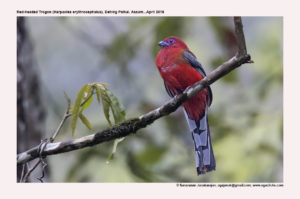Red-headed Trogon

Red-headed Trogon Harpactes erythrocephalus
Etymology:
- Harpactes : Greek Word for “Robber”
- Erythrocephalus: Greek word eruthrosred ; kephalos-headed
Vernacular names: Hindi:Hameshapiyara, Ben: M: Saudasohagin, F: Kuchkuchia, Lepcha: Sakvoor
Distribution in India: Resident of Himalayas and North East India.
Description: Size of 31–35 cm; wt. of 75–110 g. The male of nominate racehas blue bill tipped blackish, purplish-blue orbital ring,head and nape to mid-breast is dull crimson with white breastline. The mid-breast to vent is pinkish-red. Theupperparts and uppertail are rufescent-brown. The female has crimson areas replaced with brown. The juvenile is like female, but has buffish-white on lower breast, belly and flanks, and tertials and wing-coverts are strongly marked with black and buff.
Habitat: It is found in middle storey and lower canopy of dense broadleaf lower and upper montane evergreen forest and mixed bamboo, preferring interior of damp, dark evergreen cover and cool ravines. It is found from 250–2500m.
Food habits: It eats green Orthoptera, stick-insects, cicadas, millipedes, flies, beetles, centipedes, woodlice, leaves (notably bamboo) and berries. It hawks moths in early morning and evening, and takes cicadas off tree trunks.
Breeding habits: They breed inApr in China; Apr–Aug in India; Mar–May in Myanmar and Feb–Jul in Thailand. The nest is an unlined hollow on side of rotten tree trunk or old woodpecker hole in deep forest, by a track or stream. The nest is excavated by both adults. They lay a clutch of 2–4 eggs. The incubation period is 17–19 .the incubation is done by both sexes,male by day, female at night. The nestling period is 12–14 days, with young being provisioned and brooded by both sexes. The chicks are brooded exclusively by female at night and female takes greater responsibility for feeding nestlings. The young remain with adults for at least 7 weeks after fledging.